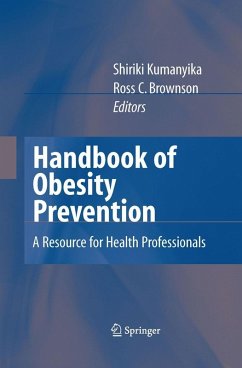A sample of topics covered:
- The individual: risk factors and prevention across the lifespan, specific populations (pregnant women, ethnic and regional groups).
- Levers for change in schools and workplaces.
- Prevention in health care systems: roles and resources.
- Community settings: role of the physical environment.
- "De-marketing" obesity: food industries and the media.
- Grassroots action: consumers and communities.
- The global obesity epidemic: rapid developments, potential solutions.
- From obesity prevention to health promotion: the future of the field.
Its level of detail and wide range of topics make the Handbook of Obesity Prevention a bedrock sourcebook, overview, reference, or teaching text. Read by topic or cover to cover, here is accurate, up-to-date information for professionals and students in all areas of public health.
Dieser Download kann aus rechtlichen Gründen nur mit Rechnungsadresse in A, B, BG, CY, CZ, D, DK, EW, E, FIN, F, GR, HR, H, IRL, I, LT, L, LR, M, NL, PL, P, R, S, SLO, SK ausgeliefert werden.
"This is a comprehensive review of the epidemic of overweight and obesity, the health consequences of obesity, and the public health responses that may prevent the worsening of this population-wide epidemic in adults and children. ... The book is intended for health professions in obesity related research, public health, and policy who are interested in broadening their view of obesity and its prevention. The book would also serve as an excellent textbook for a graduate level course in obesity prevention." (Dale A. Schoeller, Doody's Review Service, January 2008)
"Providing an overview of the public health perspective on obesity, the collection can serve as a companion piece to handbooks of obesity therapy ...This is an excellent and useful volume surveying the public health perspective on obesity. It maps out the issues confronting health care professionals who aim to prevent and reduce the prevalence of obesity." (Ann F. La Berge, PhD, JAMA, June 2008)
"The layout of the book is unique. Editing into sections and parts, Kumanyika and Brownson have grouped chapters by reciprocally influential themes that perpetuate obesity. From various philosophical and research design approaches, well-respected authors in their respective disciplines explore aspects of ... obesity and/or obstruct pragmatic remediation of it. ... The scope of the text is ambitious. The distinct sectors, for which a multitude of diverse ideas and supporting data are compiled, are extensive. ... The authors write for both the researcher and clinician reader." (Maria M. Sanzone, PsycCRITIQUES, Vol. 53 (30), 2008)









